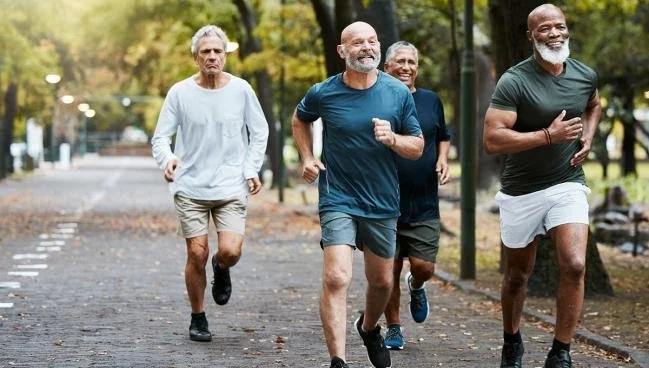Is Cardio Enough as You Age?
Why this question matters
As we age, our bodies change — muscle mass declines, bone density drops, hormones shift, and recovery takes longer. Cardiovascular (aerobic) exercise is often seen as the gold standard for staying fit and healthy, but the real question is: is cardio alone enough to maintain strength, mobility, and long-term function as you get older?
The benefits of cardio as you age
Cardiovascular exercise is incredibly valuable for maintaining health and longevity.
1. Cardiovascular and vascular health
Regular aerobic activity helps offset many of the age-related declines in heart and vascular function. It improves blood vessel flexibility, maintains cardiac efficiency, and enhances overall endurance capacity.
2. Reduced risk of chronic disease and mortality
Older adults with higher aerobic fitness have significantly lower risks of heart disease, stroke, diabetes, and premature death. The relationship is simple — better cardio fitness means a longer, healthier life.
3. Cognitive health
Cardio promotes blood flow to the brain and increases the release of BDNF (Brain-Derived Neurotrophic Factor), which supports memory and neuroplasticity. It’s one of the most powerful tools for maintaining mental sharpness with age.
4. Improved mood, sleep, and mobility
Aerobic training helps with mood regulation, stress reduction, and sleep quality. It also supports daily movement and independence by keeping the cardiovascular system strong and energy levels high.
So yes — cardio is excellent for health and longevity. But it’s only one part of the picture.
Why cardio alone isn’t enough
Relying only on cardio leaves critical gaps in your long-term health, resilience, and physical performance.
1. Muscle loss and strength decline
As we age, muscle mass and strength naturally decline — a process known as sarcopenia. Aerobic exercise alone cannot prevent this. Without resistance training, you’ll lose muscle tissue, power, and functional capacity over time.
2. Reduced bone density
Low-impact cardio like cycling or swimming doesn’t provide enough stimulus for maintaining bone strength. Strength training and load-bearing exercise are essential for reducing the risk of osteoporosis and fractures.
3. Loss of balance and coordination
Cardio activities such as walking or jogging don’t sufficiently train balance or neuromuscular control. Older adults who only do cardio often experience reduced stability and an increased risk of falls.
4. Poor strength and power output
Even if cardiovascular endurance improves, overall strength and power decline without resistance training. This affects everything from lifting groceries to climbing stairs to reacting quickly in sport or daily life.
5. Diminishing returns
There’s a limit to the benefits of cardio alone. Studies show that longevity and overall health outcomes improve the most when aerobic exercise is combined with strength and mobility training.
What a complete ageing-fitness strategy looks like
A comprehensive approach combines multiple training modalities to maintain performance, function, and independence.
Aerobic (Cardio) Training
Maintain or improve cardiovascular health through regular, varied aerobic sessions. Aim for 150–300 minutes of moderate-intensity or 75–150 minutes of vigorous activity per week. Include both steady-state sessions and intervals when appropriate.
Strength Training
Lift weights at least twice per week. Focus on progressive overload to maintain and build strength, muscle mass, and bone density. This is the foundation for resilience, stability, and injury prevention.
Power and Speed Work
Incorporate controlled explosive movements like medicine-ball throws, step-ups, or light plyometric work (as appropriate). Power output declines faster than strength with age, so maintaining it helps prevent falls and maintain independence.
Mobility and Balance Training
Add exercises that challenge stability, joint range of motion, and coordination — such as single-leg work, dynamic balance, and mobility drills. These maintain movement quality and functional control.
Recovery and Nutrition
Prioritise adequate protein intake, hydration, and quality sleep. Nutrition supports recovery and tissue repair, while proper rest helps maintain hormonal balance and training adaptations.
Key takeaways
Cardio remains essential for heart and brain health, but it doesn’t address strength, balance, or bone density.
A balanced approach combining aerobic, strength, power, and mobility training produces the best outcomes.
For adults over 50, this mix is the difference between simply ageing and ageing strong.
Think of cardio as your foundation — but not the whole structure.
Frequently Asked Questions
Q1: If I do 30–40 minutes of cardio five times a week, is that enough?
That’s an excellent foundation for cardiovascular health, but it’s not enough for maintaining muscle, bone strength, and mobility. You’ll get better results by adding two weekly strength sessions.
Q2: Can I skip weights if I’m running or cycling regularly?
No — running or cycling doesn’t provide enough resistance to maintain strength and bone density. Resistance training stimulates muscle growth, improves posture, and keeps your joints healthy.
Q3: Is high-intensity interval training (HIIT) enough on its own?
HIIT improves VO₂max and cardiovascular reserve, but it still lacks the consistent load stimulus that strength training provides. It’s best used as an addition, not a replacement.
Q4: What’s the best type of cardio for older adults?
Choose what’s enjoyable and sustainable — walking, cycling, swimming, or rowing. Add variety and progressive overload where possible. Hill walks or interval efforts can safely boost cardiovascular performance.
Q5: How should I combine cardio and strength training each week?
A simple template:
2 days of resistance training
2–3 days of cardio (mix of steady and interval)
1 day focused on mobility and recovery
1–2 rest or light activity days
Q6: Does cardio lose its value as I age?
Not at all — it remains vital for longevity, cardiovascular function, and cognitive health. But it’s only one piece of the equation. The goal should be to move often, lift regularly, and train smart.
In summary
Cardio is a cornerstone of healthy ageing — but it isn’t the full picture. Strength, power, and mobility training complete the equation by building resilience, reducing injury risk, and keeping you strong enough to enjoy life fully.
If you want to age well, move better, and stay strong for life, cardio should be part of your plan, not the whole plan.




